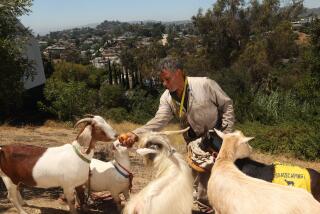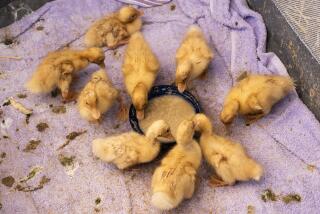Urbanites Get Dander Up After Taking Gander at Citified Canada Geese : Wildlife: Population of birds has mushroomed 50-fold in a decade. Flocks have invaded golf courses, schools, sewage-treatment plants, almost any place with grassland and a body of water.
- Share via
CHANTILLY, Va. — Jetliners thunder overhead. Cars whiz by. It’s a far cry from the wild.
But the hubbub doesn’t faze several hundred Canada geese that have made their home in a shallow pond surrounded by highways and hotels on the approach to Washington Dulles International Airport.
The flock has lived here for nearly 10 years, despite numerous attempts to relocate it. The swan-size, gray-and-black birds forage on highway median strips or waddle among airport motels looking for guests willing to part with their breakfast.
The birds are part of a mushrooming community of Canada geese believed to be descendants of birds raised by humans years ago. They don’t mind people, machines or noise. They don’t migrate; they find a spot and stay put.
In the decade that citified geese have been multiplying, wild flocks in the Atlantic flyway have declined by a third. Two reasons for the decline, experts say, are several poor nesting years in the arctic and reduced habitat caused by human encroachment.
At the same time, ironically, urban flocks of varying size have settled in cities all over the United States and in parts of Canada and the British Isles. The birds have moved onto golf courses, corporate ponds and school campuses--almost any place with open grassland and a bit of water.
Inspiring and graceful in the air, Canada geese on the ground are noisy and messy. The only thing that distinguishes the city dwellers from their country cousins is temperament.
In small numbers, the domesticated geese delight nature-starved urbanites. But without the greater dangers of living in the wild--predators and food shortages, for example--urban geese populations have exploded. East Coast cities alone are home to more than a million Canadas, 50 times more than a decade ago.
“They’ve been allowed to reproduce and reproduce,” said Martin Lowrey, Virginia director of the U.S. Agriculture Department’s Office of Animal Damage Control.
As flocks grow, so do complaints. Canada geese have fouled beaches, contaminated drinking-water supplies, created aviation hazards, ruined wetland-restoration projects and infrequently attacked humans who didn’t offer them food or came too close to their goslings.
Limited hunts have been tried, especially on golf courses, where geese tear up greens. But most urban flocks live in areas that are too populous to allow shooting.
A host of other anti-goose techniques have been explored: prohibiting feeding, replanting roosting areas with high grass that makes the birds wary of predators, crisscrossing wires over ponds to hinder takeoffs and landings, harassment by trained dogs, tethered balloons painted with huge eye spots and the use of explosives.
Most efforts have met with little success. “These geese don’t care what you do, they just stay,” said Lowrey, whose office is inundated with complaints about 30,000 Canada geese that live in the densely populated Virginia suburbs outside Washington.
Most complaints, he said, are minor. But some are serious. Guests at an Alexandria hotel have been bitten by irritable geese. Feces from a flock of 1,200 geese that roost at a Fairfax County sewage-treatment plant recontaminate water newly purified for re-release into the environment.
Complaints increase every year, said Lowrey. But there’s only so much his agency can do. Migrating birds, including Canada geese, are protected in the United States under the Migratory Bird Treaty Act, whether they actually migrate or not. Any efforts to control Canadas, from culling flocks to forcing the birds to leave on their own, must be approved by the U.S. Fish and Wildlife Service.
“We’re all hostage to the service,” Lowrey said, echoing a complaint from local officials who deal with seemingly intractable Canada goose problems.
Fish and Wildlife officials admit that they’ve been overly cautious about issuing permits to control Canadas. They’re concerned that efforts to control urban geese will counter efforts to recover wild flocks, a higher priority.
Attempting to address both problems, the service has put strict bag limits on geese taken during the regular hunting season, while at the same time allowing special goose-hunting seasons during a few warm weeks in the spring and fall when migratory flocks remain in the arctic.
But it’s almost impossible to please everybody.
Hunters say the bag limits are too strict. “Now people don’t think we have any geese,” said Randolph Murphy, who runs a hunting-guide operation in Tilghman, Md., on the Chesapeake Bay. “They’ve ruined a million-dollar business on the Eastern Shore.”
Local officials complain that special seasons do little to get at the toughest situations, which occur in urban areas.
Tennessee may be the only state that has profited from the new regulations. Promoting itself as a goose-hunters’ paradise, the state transports nuisance birds from urban areas to huntable lakes just before the special season opens.
“An unmitigated outrage,” said Holly Morgan, a wildlife activist in Arlington, Va. “They’d never get away with it anywhere else.”
Wildlife professionals look down their noses at people like Morgan, but activists play an increasing role in wildlife debates.
Until recently, urban goose problems have been a problem mainly along the Atlantic flyway and around the Great Lakes. But rapidly multiplying urban flocks are spreading to the Midwest and beyond.
Golfers in Reno, Nev., and Northern California have begun goose battles. New flocks are turning up all along the Northwest coast.
The Fish and Wildlife Service, under increasing pressure to do something, this spring will consider policy changes that would allow cities or counties to decide how to handle nuisance geese situations.
“I think we can craft something that will address the issue before it becomes a nationwide problem,” said Paul Schmidt, chief of the service’s Office of Migratory Bird Management.
But Martin Lowrey doesn’t have much hope for community-based solutions.
“Any time you let the whole community decide, nothing happens,” he said. “The people dealing with the problem are always a minority. The others always vote in favor of the geese.”
More to Read
Sign up for Essential California
The most important California stories and recommendations in your inbox every morning.
You may occasionally receive promotional content from the Los Angeles Times.













